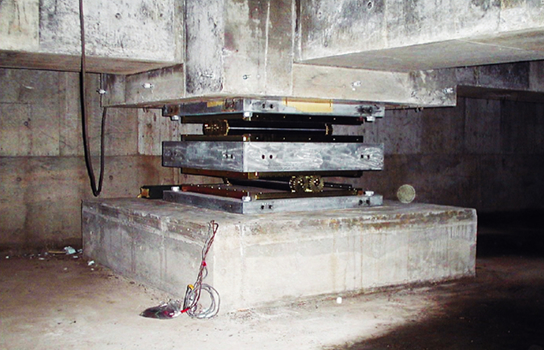Nothing can make a building “earthquake-proof”, but these five seismic construction devices mitigate an earthquake’s effects getting the structure to move with the ground’s swells.
Lead rubber bearings
Lead rubber bearings, a base isolation system, are installed on a building’s foundation to essentially decouple the structure from the ground itself. They’re constructed from rubber grommets with a lead core and allow the building to sway more easily as a unit with the force of the seismic wave. These are the most effective means of passive structural vibration control and are used heavily in seismic retrofits.
Tuned Mass Dampers
High-rises will often use a Tuned Mass Damper to minimise the effects of an earthquake’s shakes. Since a seismic wave often makes buildings oscillate unpredictably depending on a variety of factors including the frequency and direction of the quake, as well as the building’s height and construction. If the building oscillates excessively, it may fail structurally. To counteract these oscillations, tuned mass dampers — huge concrete blocks mounted in upper floors of the building — are employed. They move in opposition to the resonance frequency oscillations of the structure. The Taipei 101, for example, uses a massive four-storey steel pendulum hung from the 92nd floor to counteract lateral building sway.
Friction Pendulum Bearings
Friction pendulum bearings work similarly to Lead rubber bearings however, instead of a soil lead core, the friction pendulum uses a bearing on a curved inner plate to keep a building level as it moves back and forth — like a pendulum. This allows the structure to ride out the strongest earthquake forces with a mild, dipping motion.[imgclear]
Roller bearing
Roller bearings are similar to friction pendulum bearings but lack the dip. Two sets of isolated rollers are stacked atop one another and installed in a building’s foundations. As the Earth moves, the building simply rolls back and forth. And, since the rollers operated independently, they can account for any directional shakes.
Hysteretic Dampers
Hysteretic dampers are shock absorbers for buildings. Unlike the rest of the devices mentioned, don’t make the structure move with the quake, they simply absorb it. The most common form of Hysteretic damper is the fluid viscous damper pictured. It employs thick oils to dissipate the incoming seismic load in the same way the shocks on your car dissipate the impact of potholes.
[Wikipedia, Okumuragumi, Earthquake Protection]
Base Isolation testing in action:
